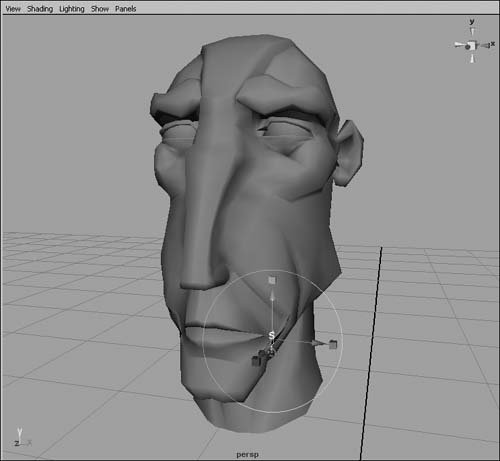| In addition to translating objects, you can use the Duplication options to create a mirror image of an object (that is, a reversed copy of the original). Body parts or characters make good candidates for mirroring because many characters are nearly symmetrical. This allows you to model one half of a character and mirror it, saving yourself almost half the work (Figure 4.54). Figure 4.54. By mirroring a character or anything symmetrical, you can save a lot of work. 
Additionally, you can create instances of objectsduplicates that retain a connection to the shape of the original (Figure 4.55). The beauty of this technique is that you can then edit any of the objects and have each of the rest follow those edits interactively. For example, if you're creating a building with multiple identical pillars, you can create one pillar and then create a number of instances of it to get the additional pillars. If you later decide to change the look of the pillars, all you have to do is edit one, and the rest will be updated automatically. Figure 4.55. Instances of objects mimic the edits of the first object interactively. Here one poly sphere reflects the change to the other. 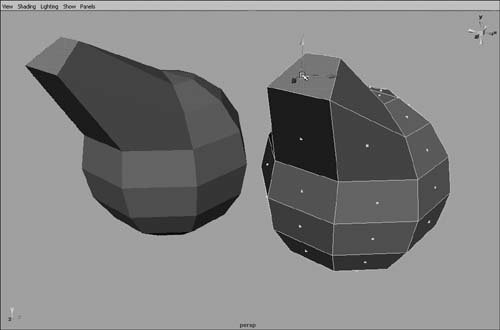
Mirroring Mirroring an object produces a precise reverse copy of the object. This technique is great for symmetrical objects, such as creating one side of a face and then mirroring the face across an axis to complete it (Figure 4.56). The pivot point is used as the mirror axis, which means that the farther the pivot point is from the object, the farther the mirrored copy will be from the original. Figure 4.56. You can create half a face and then mirror it to complete the rest of the face. 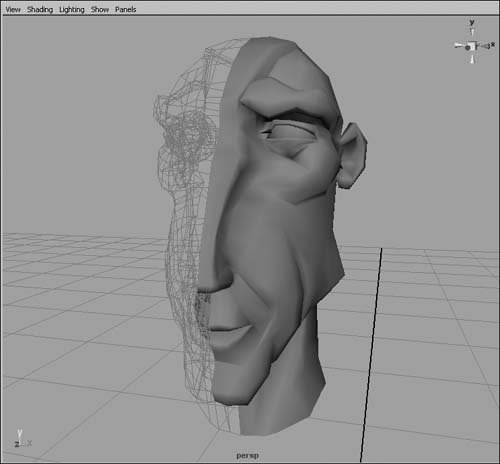
You can also use mirroring to place objects an equal distance away from an axis line, creating a mirrored copy that's perfectly placed (Figure 4.57). Figure 4.57. Any symmetrical object is ideal for mirroring. Here, a pair of tires is flipped to the other side of the x axis. 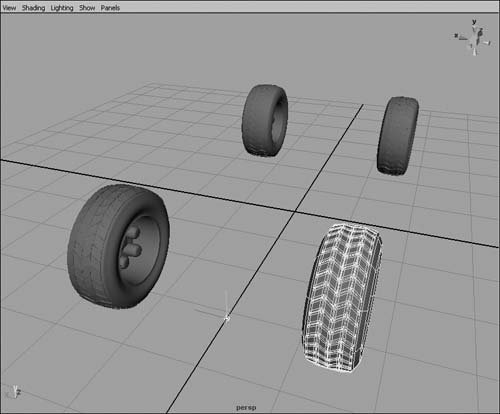
In the following task, you'll mirror a sphere across an axis, as if to create two eyes. To mirror an object: 1. | Select Create > NURBS Primitives > Sphere, or select an object to mirror.
| 2. | Type -2 in the Translate X field in the Channel Box (Figure 4.58).
Figure 4.58. Type -2 in the Translate X field of the Channel Box to move the object two units in the negative x direction. 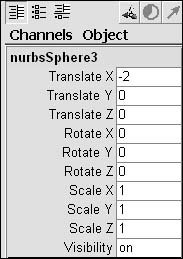
This setting moves the object two units down the negative x axis.
| 3. | Press  or click the Move tool icon or click the Move tool icon  in the toolbar. in the toolbar.
| 4. | Press  on the keyboard to go into pivot-point edit mode. on the keyboard to go into pivot-point edit mode.
| 5. | Holding down  , move the pivot point to the origin (Figure 4.59). , move the pivot point to the origin (Figure 4.59).
Figure 4.59. Move the pivot point to the origin to send the copy an equal distance away from the origin. 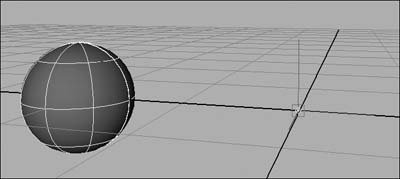
 snaps to the grid, which ensures that the pivot point is precisely at the origin. snaps to the grid, which ensures that the pivot point is precisely at the origin.
| 6. | Press  to get out of pivot-point edit mode. to get out of pivot-point edit mode.
| 7. | From the Edit menu, select the box beside Duplicate.
The Duplicate Options window opens.
| | | 8. | Select Edit > Reset Settings in the Duplicate Options window to reset the settings, and then set the Scale X field to 1.
| 9. | Click Duplicate.
A mirrored copy is duplicated an equal distance from the pivot point (Figure 4.60).
Figure 4.60. A mirrored copy is duplicated an equal distance from the pivot point. 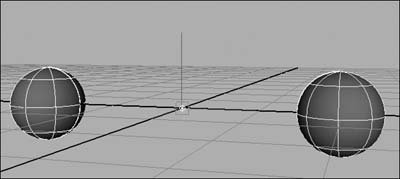
|
 Tip Tip
Instancing Instancing is a great way to save time, both in modeling and in rendering. An instanced object follows the edits of the original, making instancing ideal for any object that will have identical copies anywhere else in the scene (Figure 4.62). Instanced objects only are loaded into memory once, saving on render time. Very large scenes can be populated by instanced objects and still stay workable. You can still scale, rotate, and move the objects independently once they've been instanced. Figure 4.62. Oil drums are instanced to cut down on the number of edits that need to be made. The objects are rotated to hide their similar attributes. 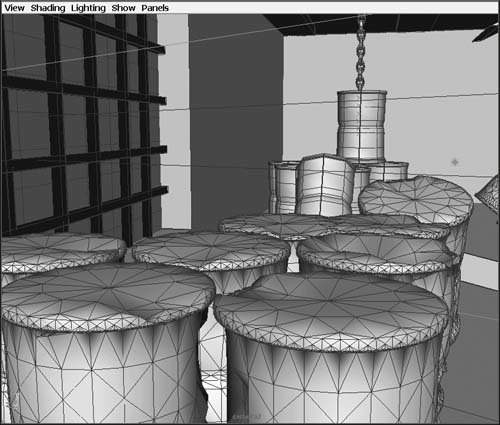
To make an instance of an object: 1. | Select an object by clicking it.
| 2. | From the Edit menu, select the box next to Duplicate.
The Duplicate Options window opens.
| | | 3. | Set the Translate X field to 2 and the rest of the Translate and Rotate fields to 0 (Figure 4.63).
Figure 4.63. Set the Translate X field to 2. 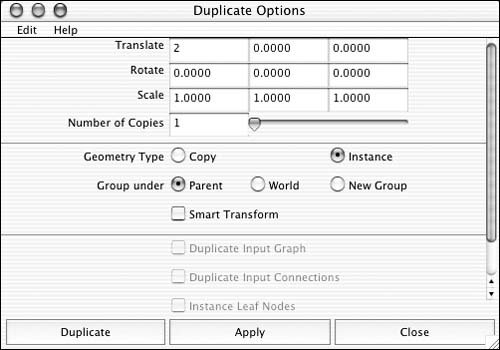
You add a translate here so the copy doesn't sit directly on top of the original.
| 4. | For Geometry Type, select Instance (Figure 4.64).
Figure 4.64. Selecting Copy duplicates the object; however, selecting Instance results in an additional connection to the original object. 
| 5. | Click Duplicate.
The duplicate is now an instance, or virtual copy, of the original.
| 6. | With one of the objects selected, press  to go into component-selection mode. to go into component-selection mode.
| 7. | Marquee-select across the top third of the object to select one of its components (Figure 4.65).
Figure 4.65. Marquee-select across the top third of the object to select control vertexes to manipulate. 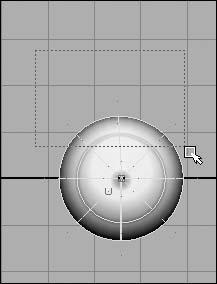
| 8. | Press  , and translate the components in any direction. , and translate the components in any direction.
Note that the other object follows the translation of the selected surface (Figure 4.66).
Figure 4.66. The other object follows the translation of the selected surface but in the opposite direction, like an object in a mirror. 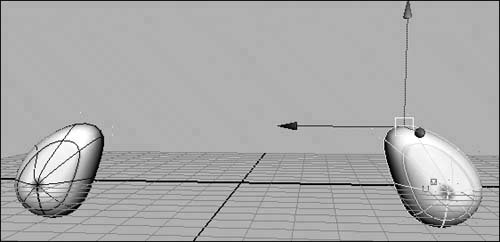
|
 Tip Tip
Once you've created an instance of an object, you can't modify its components independently. However, you can translate, rotate, or scale the whole object without affecting the other instances.
Duplicating input connections Often, you'll want the construction history to remain attached to an object when you create a copy of it. This produces an effect like instancing but allows you to alter the objects independently as well. You can do this by selecting the Duplicate Input Connections check box in the Duplicate Options window. The objects then share the same Inputs node, and both the original and the duplicates are changed by it. To duplicate an object with its input connections: 1. | Select an object that has input connections attached to ita primitive sphere, for example (Figure 4.67).
Figure 4.67. A primitive sphere's Inputs node holds the editable history of the sphere. 
| 2. | From the Edit menu, select the box next to Duplicate.
The Duplicate Options window opens.
| 3. | Select the Duplicate Input Connections check box (Figure 4.68).
Figure 4.68. Select the Duplicate Input Connections check box in the Duplicate Options window to copy the input connections to the new object. 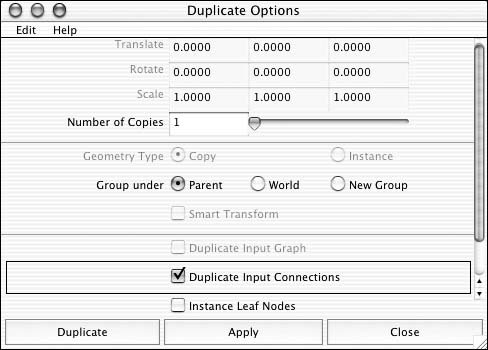
This option connects the duplicated object to the Inputs node of the original. Now, if you alter the Inputs node of one, the duplicates are also affected.
| 4. | Type the number of duplicates you want to produce in the Number of Copies field.
| | | 5. | Click Duplicate.
A copy of the object is made, and its connections are attached to it (Figure 4.69). The new object sits directly on top of the original.
Figure 4.69. The same makeNurbSphere node is connected to both spheres. 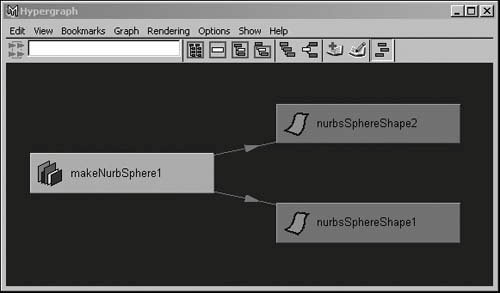
| 6. | Select the Move tool, and move the duplicated object away from the original.
| 7. | In the Channel Box, select the End Sweep attribute name, and drag the middle mouse button in the View pane to confirm the connections.
The End Sweep is changed on both objects interactively (Figure 4.70).
Figure 4.70. Since both spheres share the input node makeNurbSphere1, adjusting the sweep of that node will adjust both spheres. 
| 8. | Right-click a sphere, select CV's from the marking menu, and move a few around.
When you duplicate with input connections, you can make changes to the new copies with out affecting the rest. (Figure 4.71).
Figure 4.71. When you retain the Inputs node on duplicated objects, you can continue to make individual changes to the surfaces. 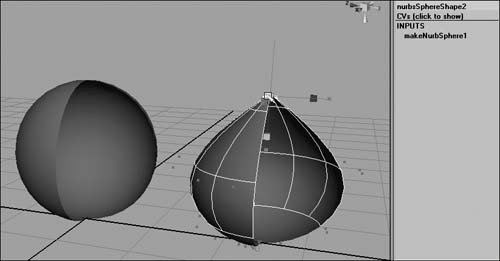
|
|








 Tip
Tip